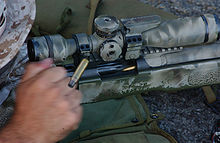
Back بندقية يدوية Arabic Qurmalı silah Azerbaijani Fusell de forrellat Catalan Opakovací zbraň Czech Fusil de cerrojo Spanish Käsilukk Estonian Morroilo-fusil Basque تفنگ گلنگدنی Persian Pulttilukko Finnish Mécanisme à verrou French
This article includes a list of general references, but it lacks sufficient corresponding inline citations. (August 2019) |



Bolt-action is a type of manual firearm action that is operated by directly manipulating the turn-bolt via a bolt handle, most commonly placed on the right-hand side of the firearm (as most users are right-handed). The majority of bolt-action firearms are rifles, but there are also some variants of shotguns and handguns that are bolt-action.
Bolt-action firearms are generally repeating firearms, but many single-shot designs are available particularly in shooting sports where single-shot firearms are mandated, such as most Olympic and ISSF rifle disciplines.
From the late 19th century all the way through both World Wars, bolt-action rifles were the standard infantry service weapons for most of the world's military forces, with the exception of the United States Armed Forces, who used the M1 Garand Semi-automatic rifle. In modern military and law enforcement after the Second World War, bolt-action firearms have been largely replaced by semi-automatic and selective-fire firearms, and have remained only as sniper rifles due to the design's inherent potential for superior accuracy and precision, as well as ruggedness and reliability compared to self-loading designs.
Most bolt-action firearms use a rotating bolt operation,[dubious – discuss] where the handle must first be rotated upward to unlock the bolt from the receiver, then pulled back to open the breech and allowing any spent cartridge case to be extracted and ejected. This also cocks the striker within the bolt (either on opening or closing of the bolt depending on the gun design) and engages it against the sear. When the bolt is returned to the forward position, a new cartridge (if available) is pushed out of the magazine and into the barrel chamber, and finally the breech is closed tight by rotating the handle down so the bolt head relocks on the receiver. A less common bolt-action type is the straight-pull mechanism, where no upward handle-turning is needed and the bolt unlocks automatically when the handle is pulled rearwards by the user's hand.